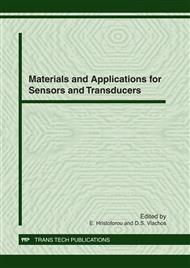[1]
E. Hristoforou, J. Opt. Adv. Mat., 4, (2002) 245-260.
Google Scholar
[2]
K. Kosmas, C. Sargentis, D. Tsamakis, E. Hristoforou, J. Mat. Proc. Tech., 161, (2005) 359-362.
Google Scholar
[3]
E. Hristoforou, R.E. Reilly, D. Niarchos, IEEE Trans. Magn., 29, (1993) 3171-3173, (1993).
DOI: 10.1109/20.281126
Google Scholar
[4]
K. Kosmas, E. Hristoforou, International J. of App. Electr. and Mech., 25, (2007)319-324.
Google Scholar
[5]
E. Hristoforou, Review Article, Meas. Sci. & Technol., 14, (2003) R15-R47.
Google Scholar
[6]
E. Hristoforou, D. Niarchos, H. Chiriac, M. Neagu, Sens. & Actuators A, 92, (2001) 132-136.
Google Scholar
[7]
E. Hristoforou, K. Kosmas, Int. J. of Appl. Electrom. and Mechanics, 25, (2007) 287-296.
Google Scholar
[8]
E. Hristoforou and R.E. Reilly, J. Magn. Magn. Mat., 119, (1993) 247-253, (1993).
Google Scholar
[9]
E. Hristoforou, K. Kosmas, M. Kollar, Journal of Electrical Engineering, 59, (2008) 90-93.
Google Scholar
[10]
B. Augustyniak, L. Piotrowski, M. Chmielewski, K. Kosmas, E. Hristoforou, IEEE Trans. Magn., 46, (2010) 544-547.
DOI: 10.1109/tmag.2009.2033340
Google Scholar
[11]
L. Piotrowski, B. Augustyniak, M. Chmielewski, E. Hristoforou, K. Kosmas, IEEE Trans. Magn., 46, (2010) 239-242.
DOI: 10.1109/tmag.2009.2034020
Google Scholar
[12]
M. Küpferling, F. Fiorillo, V. Basso, G. Bertotti, P. Meilland, J. Mag. Mag. Mat., 320, (2008) 527-530.
Google Scholar
[13]
T. Liu, H. Kikuchi, Y. Kamada, K. Ara, S. Kobayashi, S. Takahashi, 310, (2007) 989-991.
Google Scholar
[14]
A. Dhar, L. Clapham, D. L. Atherton, NDT & E International, 34, (2001) 507-514.
Google Scholar
[15]
D.S. Vlachos, C.A. Papadopoulos and J.N. Avaritsiotis, Sensors and Actuators B 44 (1997) 239.
Google Scholar
[16]
D.S. Vlachos and C. Tsabaris, Nuclear Instruments and Methods in Physics Research, Section A Vol. 539, 414 (2005).
Google Scholar
[17]
C.A. Papadopoulos, D.S. Vlachos and J.N. Avaritsiotis, Sensors and Actuators B 34 (1996) 524.
Google Scholar
[18]
P.D. Skafidas, D.S. Vlachos and J.N. Avaritsiotis, Sensors and Actuators B 18-19 (1994) 724.
Google Scholar
[19]
C. A. Papadopoulos, D.S. Vlachos and J.N. Avaritsiotis, Sensors and Actuators B 42 (1997) 95.
Google Scholar
[20]
D.S. Vlachos, P.D. Skafidas and J.N. Avaritsiotis, Applied Physics Letters 63 (13) (1993) 1760.
Google Scholar


